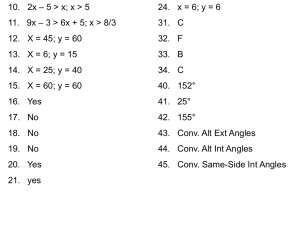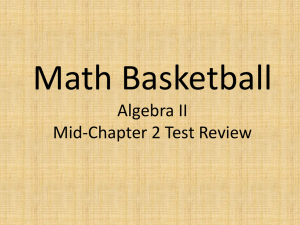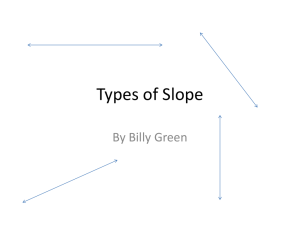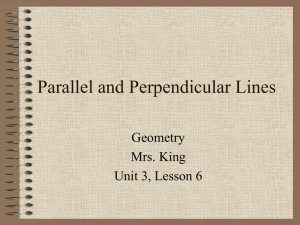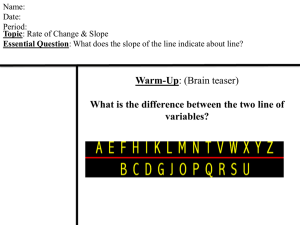Cartesian Plane and Linear Equations in Two Variables
advertisement
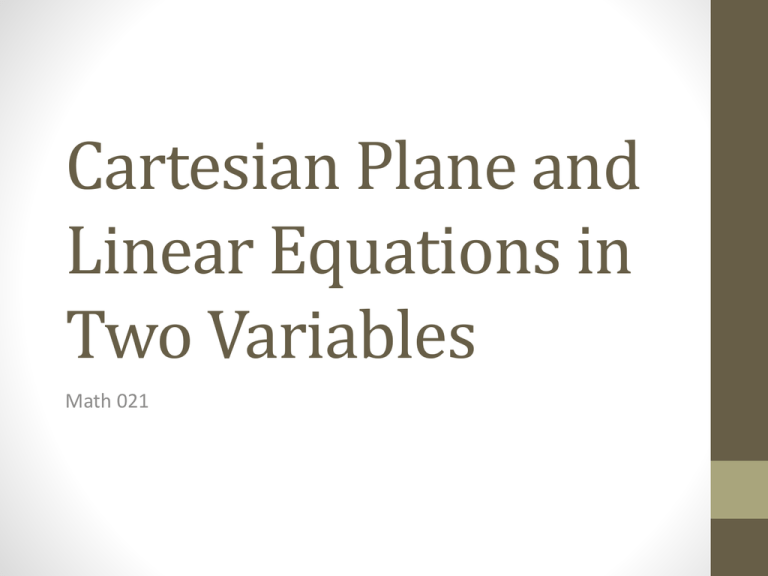
Cartesian Plane and Linear Equations in Two Variables Math 021 • The Cartesian Plane (coordinate grid) is a graph used to show a relationship between two variables. • The horizontal axis is called the x-axis. • The vertical axis is called the y-axis. • The point of intersection of the x-axis and y-axis is called the origin. • The axes divide the Cartesian Plane into four quadrants. • An ordered pair is a single point on the Cartesian Plane. Ordered pairs are of the form (x,y) where the first value is called the x-coordinate and the second value is called the y-coordinate. Examples – Plot each if the following ordered pairs on the Cartesian Plane and name the quadrant it lies in: 10 9 8 7 6 5 4 3 2 1 -10 -9 -8 -7 -6 -5 -4 -3 -2 -1 0 -1 -2 -3 -4 -5 -6 -7 -8 -9 -10 1 2 3 4 5 6 7 8 9 10 a. b. c. d. e. f. A = (3, 4) B = (-2, 1) C = (7, -3) D = (-4, -2) E = (0, 5) F = (-1, 0) • Linear Equations in Two Variables • A linear equation in two variables is an equation of the form Ax + By = C where A, B, and C are real numbers. • The form Ax + By = C is called the standard form of a linear equation in two variables. • An ordered pair is a solution to a linear equation in two variables if it satisfies the equation when the values of x and y are substituted. • Examples – Determine if the ordered pair is a solution to each linear equation: • a. 2x – 3y = 6; (6, 2) • b. y = 2x + 1; (-3, 5) • c. 2x = 2y – 4; (-2, -8) • d. 10 = 5x + 2y; (-4, 15) • Examples – Find the missing coordinate in each ordered par given the equation: • a. -7y = 14x; (2, __ ) • b. y = -6x + 1; ( ____, -11) • c. 4x + 2y = 8; (1, __ ) • d. x – 5y = -1; ( ____, -2) Complete the table of values for each equation: • y = 2x – 10 x y x + 3y = 9 x 4 0 -20 5 y 6 4 Graphing Linear Equations in Two Variables • The graph of an equation in two variables is the set of all points that satisfies the equation. • A linear equation in two variables forms a straight line when graphed on the Cartesian Plane. • A table of values can be used to generate a set of coordinates that lie on the line. Graph: 2x + y = 4 10 9 8 7 6 5 4 3 2 1 -10 -9 -8 -7 -6 -5 -4 -3 -2 -1 0 -1 -2 -3 -4 -5 -6 -7 -8 -9 -10 1 2 3 4 5 6 7 8 9 10 Graph: y= 3x-1 10 9 8 7 6 5 4 3 2 1 -10 -9 -8 -7 -6 -5 -4 -3 -2 -1 0 -1 -2 -3 -4 -5 -6 -7 -8 -9 -10 1 2 3 4 5 6 7 8 9 10 Graph: y= 2x 10 9 8 7 6 5 4 3 2 1 -10 -9 -8 -7 -6 -5 -4 -3 -2 -1 0 -1 -2 -3 -4 -5 -6 -7 -8 -9 -10 1 2 3 4 5 6 7 8 9 10 Graph: 15= -5y + 3x 10 9 8 7 6 5 4 3 2 1 -10 -9 -8 -7 -6 -5 -4 -3 -2 -1 0 -1 -2 -3 -4 -5 -6 -7 -8 -9 -10 1 2 3 4 5 6 7 8 9 10 Intercepts • An intercept is a point on a graph which crosses an axis. • An x-intercept crosses the x-axis. The y-coordinate of any xintercept is 0. • A y-intercept crosses the y-axis. The x-coordinate of any yintercept is 0. Graph by Finding Intercepts: 3x – 2y = 12 10 9 8 7 6 5 4 3 2 1 -10 -9 -8 -7 -6 -5 -4 -3 -2 -1 0 -1 -2 -3 -4 -5 -6 -7 -8 -9 -10 1 2 3 4 5 6 7 8 9 10 Graph by Finding Intercepts: y= -2x + y 10 9 8 7 6 5 4 3 2 1 -10 -9 -8 -7 -6 -5 -4 -3 -2 -1 0 -1 -2 -3 -4 -5 -6 -7 -8 -9 -10 1 2 3 4 5 6 7 8 9 10 Graph by Finding Intercepts: 4x + 3y = -12 10 9 8 7 6 5 4 3 2 1 -10 -9 -8 -7 -6 -5 -4 -3 -2 -1 0 -1 -2 -3 -4 -5 -6 -7 -8 -9 -10 1 2 3 4 5 6 7 8 9 10 Graph by Finding Intercepts: 3x – 5y = -15 10 9 8 7 6 5 4 3 2 1 -10 -9 -8 -7 -6 -5 -4 -3 -2 -1 0 -1 -2 -3 -4 -5 -6 -7 -8 -9 -10 1 2 3 4 5 6 7 8 9 10 Horizontal and Vertical Lines • A horizontal line is a line of the form y = c, where c is a real number. • A vertical line is a line of the form x = c, where c is a real number. Graph: x = 4 10 9 8 7 6 5 4 3 2 1 -10 -9 -8 -7 -6 -5 -4 -3 -2 -1 0 -1 -2 -3 -4 -5 -6 -7 -8 -9 -10 1 2 3 4 5 6 7 8 9 10 Graph: y= -2 10 9 8 7 6 5 4 3 2 1 -10 -9 -8 -7 -6 -5 -4 -3 -2 -1 0 -1 -2 -3 -4 -5 -6 -7 -8 -9 -10 1 2 3 4 5 6 7 8 9 10 Graph: 3x = -15 10 9 8 7 6 5 4 3 2 1 -10 -9 -8 -7 -6 -5 -4 -3 -2 -1 0 -1 -2 -3 -4 -5 -6 -7 -8 -9 -10 1 2 3 4 5 6 7 8 9 10 Graph: y + 3 = 4 10 9 8 7 6 5 4 3 2 1 -10 -9 -8 -7 -6 -5 -4 -3 -2 -1 0 -1 -2 -3 -4 -5 -6 -7 -8 -9 -10 1 2 3 4 5 6 7 8 9 10 Slope of a Line • The slope of a line is the degree of slant or tilt a line has. The letter “m” is used to represent the slope of a line. • Slope can be defined in several ways: • Examples - Find the slope of each line: • a. Containing the points (3, -10) and (5, 6) • b. Containing the points (-4, 20) and (-8, 8) • Find the slopes of the lines below: Slopes of Horizontal & Vertical Lines • The slope of any horizontal line is 0 • The slope of any vertical line is undefined • Examples – Graph each of the following lines then find the slope • x= -3 3y -2 = 4 10 10 9 9 8 8 7 7 6 6 5 5 4 4 3 3 2 2 1 -10 -9 -8 -7 -6 -5 -4 -3 -2 -1 0 -1 -2 -3 -4 1 1 2 3 4 5 6 7 8 9 10 -10 -9 -8 -7 -6 -5 -4 -3 -2 -1 0 -1 -2 -3 -4 -5 -5 -6 -6 -7 -7 -8 -8 -9 -9 -10 -10 1 2 3 4 5 6 7 8 9 10 Slope-Intercept form of a Line • The slope-intercept form of a line is y = mx + b where m is the slope and the coordinate (0,b) is the y-intercept. • The advantage equation of a line written in this form is that the slope and yintercept can be easily identified. Examples – Find the slope and yintercept of each equation: •a. •b. •c. •d. y = 3x – 2 4y = 5x + 8 4x + 2y = 7 5x – 7y = 11 Parallel and Perpendicular Slopes • Two lines that are parallel to one another have the following properties • • • • They will never intersect They have the same slopes They have different y-intercepts Parallel lines are denoted by the symbol // • Two lines that are perpendicular to one another have the following properties: • They intersect at a angle • The have opposite and reciprocal slopes • Perpendicular lines are denoted by the symbol ┴ Complete the following table: Slope a. 2 7 b. 5 c. 0 // Slope ┴ slope Examples – Determine if each pair of lines is parallel, perpendicular, or neither: • a. 2y = 4x + 7 y – 2x = -3 • c. 3x + 4y = 3 4x + 5y = -1 b. 5x – 10y = 6 y = 2x + 7 d. Line 1 contains points (3,1) and (2,7) Line 2 contains points (8,5) and (2,4)
